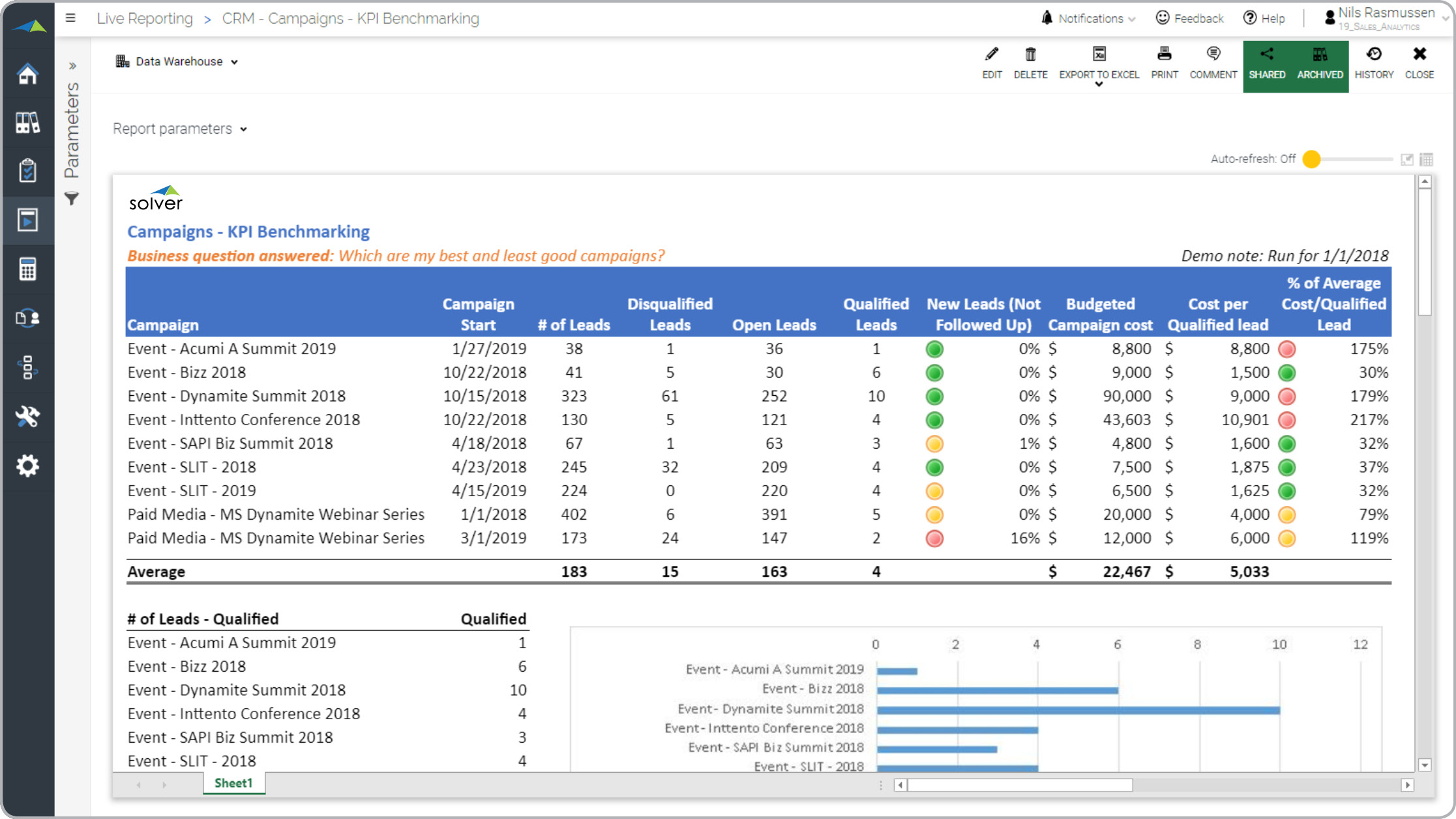Related Posts
- Subscription Billing Auto Forecast for SaaS Companies using Dynamics 365 Business Central
- Top 50 Opportunities Report for SaaS Companies using Dynamics 365 BC
- Subscription Sales by Contract Length Report for SaaS Companies using Dynamics 365 Business Central
- Multi-Year Profit & Loss Forecast Model for SaaS Companies using Dynamics 365 Business Central
- Lead Target Model for SaaS Companies using Dynamics 365 Business Central
Marketing Campaign Analysis Report
 Purpose of
Campaign Analysis Reports Companies and organizations use Campaign Analysis Reports to easily benchmark campaigns against each other to see which ones produces the best result compared to the investment. When used as part of good business practices in a Marketing department, a company can improve its revenues by investing in the best possible campaigns as well as reduce the chances that money and marketing budgets are wasted on poor performing campaigns.
Campaign Analysis Report
Example Here is an example of a modern and automated Campaign Analysis Report that provides essential KPIs and benchmarking. [caption id="" align="alignnone" width="2233"]
Purpose of
Campaign Analysis Reports Companies and organizations use Campaign Analysis Reports to easily benchmark campaigns against each other to see which ones produces the best result compared to the investment. When used as part of good business practices in a Marketing department, a company can improve its revenues by investing in the best possible campaigns as well as reduce the chances that money and marketing budgets are wasted on poor performing campaigns.
Campaign Analysis Report
Example Here is an example of a modern and automated Campaign Analysis Report that provides essential KPIs and benchmarking. [caption id="" align="alignnone" width="2233"]
 Marketing Campaign Analysis Report Example[/caption] You can find hundreds of additional examples
here
Who Uses This Type of
Report
? The typical users of this type of report are: Marketing managers, budget users, sales executives.
Other
Report
s Often Used in Conjunction with
Campaign Analysis Reports Progressive Marketing Departments sometimes use several different Campaign Analysis Reports, along with pipeline reports, campaign dashboards, marketing simulation dashboards, marketing budget models, lead and opportunity reports and other management and control tools.
Where Does the Data for Analysis Originate From? The Actual (historical transactions) data typically comes from CRM and enterprise resource planning (ERP) systems like: Microsoft Dynamics 365 (D365) Finance, Microsoft Dynamics 365 Business Central (D365 BC), Microsoft Dynamics AX, Microsoft Dynamics NAV, Microsoft Dynamics GP, Microsoft Dynamics SL, Dynamics 365 (CRM), Sage Intacct, Sage 100, Sage 300, Sage 500, Sage X3, SAP Business One, SAP ByDesign, Acumatica, Netsuite, Salesforce and others. In analyses where budgets or forecasts are used, the planning data most often originates from in-house Excel spreadsheet models or from professional corporate performance management (CPM/EPM) solutions.
What Tools are Typically used for Reporting, Planning and Dashboards? Examples of business software used with the data and ERPs mentioned above are:
Marketing Campaign Analysis Report Example[/caption] You can find hundreds of additional examples
here
Who Uses This Type of
Report
? The typical users of this type of report are: Marketing managers, budget users, sales executives.
Other
Report
s Often Used in Conjunction with
Campaign Analysis Reports Progressive Marketing Departments sometimes use several different Campaign Analysis Reports, along with pipeline reports, campaign dashboards, marketing simulation dashboards, marketing budget models, lead and opportunity reports and other management and control tools.
Where Does the Data for Analysis Originate From? The Actual (historical transactions) data typically comes from CRM and enterprise resource planning (ERP) systems like: Microsoft Dynamics 365 (D365) Finance, Microsoft Dynamics 365 Business Central (D365 BC), Microsoft Dynamics AX, Microsoft Dynamics NAV, Microsoft Dynamics GP, Microsoft Dynamics SL, Dynamics 365 (CRM), Sage Intacct, Sage 100, Sage 300, Sage 500, Sage X3, SAP Business One, SAP ByDesign, Acumatica, Netsuite, Salesforce and others. In analyses where budgets or forecasts are used, the planning data most often originates from in-house Excel spreadsheet models or from professional corporate performance management (CPM/EPM) solutions.
What Tools are Typically used for Reporting, Planning and Dashboards? Examples of business software used with the data and ERPs mentioned above are:
- Native ERP report writers and query tools
- Spreadsheets (for example Microsoft Excel)
- Corporate Performance Management (CPM) tools (for example Solver)
- Dashboards (for example Microsoft Power BI and Tableau)
 Corporate Performance Management (CPM) Cloud Solutions and More Examples
Corporate Performance Management (CPM) Cloud Solutions and More Examples
- View 100’s of reporting, consolidations, planning, budgeting, forecasting and dashboard examples here
- See how reports are designed in a modern report writer using a cloud-connected Excel add-in writer
- Discover how the Solver CPM solution delivers financial and operational reporting
- Discover how the Solver CPM solution delivers planning, budgeting and forecasting
- Watch demo videos of reporting, planning and dashboards
TAGS: Reporting, Consolidation, Forecasting, Analysis, Budgeting, CRM, CPM, KPIs, ERP, Dashboards, Financial Reporting, Template Library
Global Headquarters
Solver, Inc.
Phone: +1 (310) 691-5300
